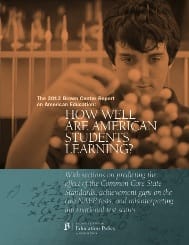
|
Few education analysts are as knowledgeable and provocative as the Brookings Institution’s Tom Loveless, and many denizens of the policy sphere look forward to his annual Brown Center Report on American Education. This year’s edition is no disappointment. As in earlier years, it tackles three big topics and manages to be provocative—and out of the mainstream—on all three.
But it’s real easy to misinterpret its message and misconstrue its policy implications.
Topic I has been read as saying that “the Common Core standards won’t raise student achievement.” Of course they won’t, not all by themselves. Standards merely describe the desired destination of the education journey; they don’t get us there. As Kathleen Porter-Magee has carefully pointed out on Fordham’s Common Core Watch blog, to achieve their potential, these standards must be well and fully implemented and joined to quality assessments, accountability systems, and much more. It’s possible to have good standards and low achievement (look at California and D.C.) and it’s possible to have weak standards and pretty good achievement (Connecticut and Vermont are good examples on this front). But, other things being equal, it’s far better to set a destination worth reaching than to embark on a random journey, and it’s far more helpful to those who will do the curriculum-building, the assessment-creating, and the classroom-instructing.
Topic II basically explains why achievement, and achievement gaps, are not the same on two different versions of NAEP, one of which is anchored to past curricular norms (the “long-term trend” assessment) and the other of which (“main NAEP”) is periodically refreshed to keep pace with current thinking about curriculum and pedagogy. As Loveless notes, “they may both be right.” But one should draw scant comfort from the fact that sundry achievement gaps are wider on “main NAEP” than on the long-term trend report. If—and in my mind it’s a sizable if—main NAEP truly reflects the knowledge and skills of greatest salience and value in today’s world, then those are what poor and minority kids also need to learn.
Standards merely describe the desired destination of the education journey.
Topic III explores a favorite Loveless topic, namely the uses and abuses of international test scores. He correctly observes that the media often exaggerate the weakness of American students by using the international score rankings in a misleading way and that, for a variety of important statistical reasons, scores that appear to be different may not actually be. Mostly, though, he objects to efforts—by many, beginning with the OECD itself—to devise causal explanations and extract policy guidance from such rankings. As Loveless irrefutably observes, “pointing to a single high-scoring country, or group of them, and declaring that one or more of their policies should be adopted by other countries is misguided. It combines the errors of making dubious causal claims and misusing rankings, and by ignoring evidence from low or average countries in the same policy question, produces a triple error, a true whopper in misinterpreting international test scores.”
Tom Loveless, The 2012 Brown Center Report on American Education: How Well Are American Students Learning? (Washington, D.C.: Brookings Institute, February 2012.)
